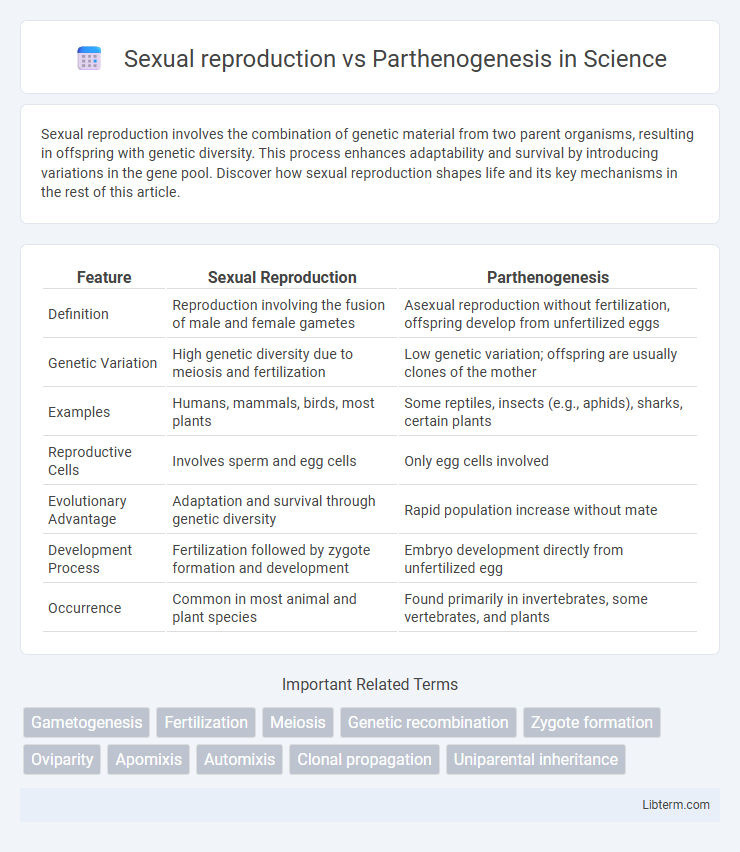Sexual reproduction involves the combination of genetic material from two parent organisms, resulting in offspring with genetic diversity. This process enhances adaptability and survival by introducing variations in the gene pool. Discover how sexual reproduction shapes life and its key mechanisms in the rest of this article.
Table of Comparison
| Feature | Sexual Reproduction | Parthenogenesis |
|---|---|---|
| Definition | Reproduction involving the fusion of male and female gametes | Asexual reproduction without fertilization, offspring develop from unfertilized eggs |
| Genetic Variation | High genetic diversity due to meiosis and fertilization | Low genetic variation; offspring are usually clones of the mother |
| Examples | Humans, mammals, birds, most plants | Some reptiles, insects (e.g., aphids), sharks, certain plants |
| Reproductive Cells | Involves sperm and egg cells | Only egg cells involved |
| Evolutionary Advantage | Adaptation and survival through genetic diversity | Rapid population increase without mate |
| Development Process | Fertilization followed by zygote formation and development | Embryo development directly from unfertilized egg |
| Occurrence | Common in most animal and plant species | Found primarily in invertebrates, some vertebrates, and plants |
Introduction to Sexual Reproduction and Parthenogenesis
Sexual reproduction involves the fusion of male and female gametes, resulting in genetically diverse offspring through meiosis and fertilization processes. Parthenogenesis is a form of asexual reproduction where offspring develop from unfertilized eggs, commonly observed in certain insects, reptiles, and amphibians. Both reproduction strategies impact genetic diversity, evolutionary adaptation, and species survival.
Defining Sexual Reproduction
Sexual reproduction involves the fusion of male and female gametes, resulting in offspring with genetic contributions from both parents, which increases genetic diversity. Parthenogenesis, in contrast, is a form of asexual reproduction where offspring develop from unfertilized eggs, producing genetically similar or identical individuals. Defining sexual reproduction centers on the combination of haploid gametes to form a diploid zygote, promoting adaptation and variation within populations.
Understanding Parthenogenesis
Parthenogenesis is a form of asexual reproduction in which offspring develop from unfertilized eggs, bypassing the genetic contribution of a male. This reproductive strategy is observed in various species, including certain insects, reptiles, and amphibians, allowing rapid population growth and survival in environments with scarce mates. Understanding parthenogenesis reveals insights into genetic diversity limitations and the evolutionary trade-offs compared to sexual reproduction, where genetic recombination enhances variability and adaptability.
Key Differences Between Sexual Reproduction and Parthenogenesis
Sexual reproduction involves the fusion of male and female gametes, resulting in genetic variation among offspring, whereas parthenogenesis is a form of asexual reproduction where offspring develop from unfertilized eggs, producing clones of the parent. Sexual reproduction requires two parent organisms and promotes genetic diversity through meiosis and fertilization, while parthenogenesis occurs without fertilization and typically leads to less genetic diversity. The key difference lies in genetic recombination and parental involvement, influencing evolutionary adaptability and population dynamics.
Genetic Diversity: Sexual Reproduction vs Parthenogenesis
Sexual reproduction generates high genetic diversity through the combination of alleles from two parents, promoting adaptability and evolution by mixing different gene pools. In contrast, parthenogenesis produces offspring genetically identical or very similar to the single parent, resulting in low genetic variation and reduced ability to adapt to environmental changes. This fundamental difference in genetic diversity impacts species survival strategies and evolutionary potential.
Evolutionary Advantages and Disadvantages
Sexual reproduction promotes genetic diversity through the combination of alleles from two parents, enhancing adaptability to changing environments and resistance to pathogens. Parthenogenesis allows rapid population increase without the need for mates, beneficial in stable or isolated habitats but limits genetic variation, increasing susceptibility to environmental changes and diseases. The evolutionary trade-off hinges on sexual reproduction's higher energy cost and slower reproduction rates versus parthenogenesis's efficiency with risk of reduced evolutionary flexibility.
Occurrence in Nature: Species Examples
Sexual reproduction occurs widely across animals, plants, and fungi, seen in species such as mammals like lions, flowering plants like orchids, and fungi like mushrooms. Parthenogenesis, a form of asexual reproduction where offspring develop without fertilization, is found in some reptiles like Komodo dragons, certain insects including aphids, and some fish species such as the Amazon molly. These reproductive strategies highlight diverse evolutionary adaptations to environmental pressures and resource availability.
Environmental Factors Influencing Reproduction Modes
Environmental factors such as resource availability, population density, and predation pressure significantly influence reproductive modes in organisms. Sexual reproduction is favored in unstable or changing environments due to increased genetic diversity, enhancing adaptability and survival. Parthenogenesis often occurs in stable, resource-rich conditions where rapid population growth is advantageous, minimizing the cost of finding mates while maintaining reproductive efficiency.
Implications for Survival and Adaptation
Sexual reproduction enhances genetic diversity through the combination of alleles from two parents, increasing a population's adaptive potential and resilience to environmental changes and disease. Parthenogenesis produces genetically uniform offspring from a single parent, enabling rapid population growth and colonization in stable environments but limiting adaptability to new threats. The trade-off between genetic variation in sexual reproduction and reproductive efficiency in parthenogenesis critically influences species survival under fluctuating ecological conditions.
Future Research and Applications in Reproductive Biology
Future research in reproductive biology explores enhancing genetic diversity through sexual reproduction to improve offspring resilience and adaptability. Parthenogenesis offers promising applications in agriculture and conservation by enabling rapid population expansion without the need for fertilization. Advances in gene editing and reproductive technologies aim to integrate both reproductive strategies to optimize fertility treatments and species preservation.
Sexual reproduction Infographic

 libterm.com
libterm.com